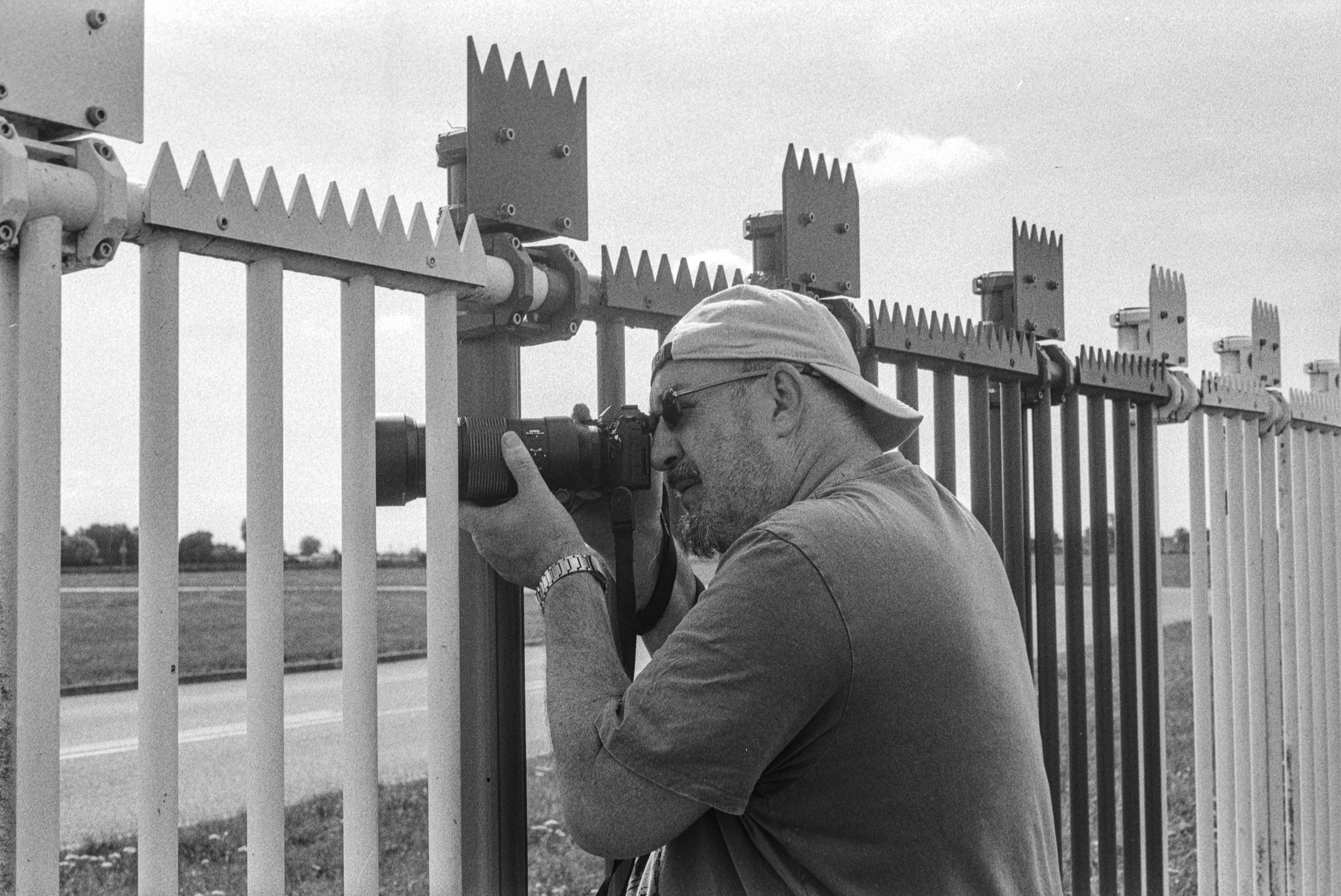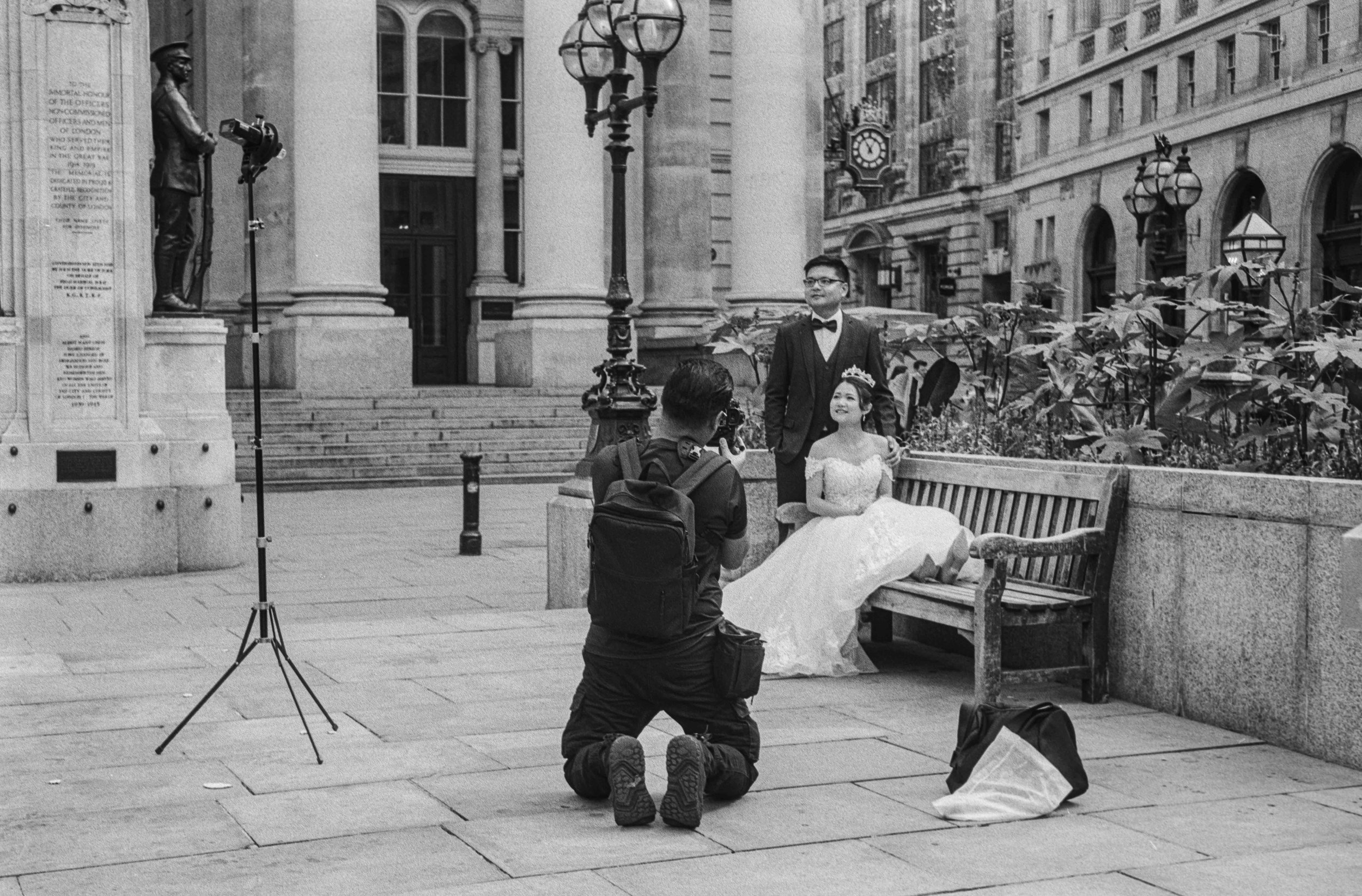Pushing Ilford FP4+ to ISO 200
The puparazzi were out in full force in London that day. 1/60s 50mm F8.0 Kodak Retina iiiS Ilford FP4+ Pushed to ISO 200.
If you’ve seen last week’s blog, then you’ll know that I’ve made my first attempts at pushing and pulling film. Pulling film to a lower ISO produces a more high key image with increased shadow detail and less contrast. Pushing film to a higher ISO creates the opposite effect and gives a more contrasty image with more shadow depth. For a full overview please do read the previous blog if you haven’t already.
This first shot of a Lancaster Bomber shows off the increased contrast from pushing film to a higher ISO. 1/125s 50mm F11 Kodak Retina iiiS Ilford FP4+ Pushed to ISO 200.
This scene of a man shooting through a multicoloured fence worked well with the increased contrast. 1/125s 50mm F11 Kodak Retina iiiS Ilford FP4+ Pushed to ISO 200.
After having pulled Ilford HP5+ from ISO 400 to ISO 200, this time I will be pushing Ilford FP4+ from ISO 125 to ISO 200. Not quite a full stop but it makes for a good comparison. Again I shot this with my Kodak Retina iiiS so the gear was consistent but I shot the roll across two different days. One when I was visiting RAF Coningsby (click here to read the full blog on that day out) and another when I went into London in the aftermath of the Queen passing away last year.
The crew on our day out to photograph the fighter jets at RAF Coningsby. I think there is actually too much contrast here, I don’t feel the skin and dark clothing of the people has been rendered well. 1/250s 50mm F8.0 Kodak Retina iiiS Ilford FP4+ Pushed to ISO 200.
An example of the shutter shake I experiences on some of my shots. 1/125s 50mm F8.0 Kodak Retina iiiS Ilford FP4+ Pushed to ISO 200.
One thing I will caveat is that the day in London was duller than the one at RAF Coningsby, and reaching for small apertures with an older rangefinder camera meant I was dropping down to lower shutter speeds, slow enough to introduce a bit of shutter shake to a few of my images. This gave me a more negative perception to some of these photos that has nothing to do with the effects of pushing the film. One thing I’ve been guilty of since I started shooting with older cameras is stopping down the aperture too much to make sure everything is in focus. It became a bit of a crutch and it’s something I intend to avoid going forward.
A policeman stands guard outside Buckingham Palace. 1/125s 50mm F8.0 Kodak Retina iiiS Ilford FP4+ Pushed to ISO 200.
Many candles were left in tribute after the Queen’s passing. I feel the increased contrast perfectly suits this image with a large amount of lighter tones. 1/125s 50mm F8.0 Kodak Retina iiiS Ilford FP4+ Pushed to ISO 200.
Looking at the results I can see the increased amounts of contrast straight away, and there’s definitely more there than in comparison to the pulled HP5+ I shot before. There’s also more pronounced grain compared to shooting it at the box speed of ISO 125 and I would say it’s the same or possible worse than the pulled roll of HP5+. As ever HP5+ shows off its versatility.
One of the few shots I took wide open. The heavier grain doesn’t spoil the bokeh. 1/60s 50mm F2.8 Kodak Retina iiiS Ilford FP4+ Pushed to ISO 200.
Tower Bridge always makes for a good subject and I managed to capture a double-decker bus exactly halfway between the two towers. 1/60s 50mm F5.6 Kodak Retina iiiS Ilford FP4+ Pushed to ISO 200.
Reflecting on the results I don’t think I would push FP4+ in 35mm (or 120 roll film) again. It’s not really necessary as there’s no shortage of ISO 400 black and white film stocks, however I could potentially see myself doing it for sheet film where I think the effect would be much more pronounced with the greater tonal range of a much larger piece of film. There’s also the other obvious scenario of being out somewhere and only having a roll of FP4+ when the conditions are overly dull. But again, I don’t see that being very likely. Though if you do want to make sure that shadow and highlight detail isn’t lost on a very bright and contrasty day or think that an otherwise very flat image needs more contrast then pushing and pulling may be the answer. Though perhaps not for films with such wide tonal ranges as FP4+ and HP5+. Contrastier T-grain film stocks like Ilford Delta 100 and Kodak T-Max 100 may benefit a lot more.
This shot of the towers of Westminster Abbey also benefited well from the increased contrast. 1/125s 50mm F8.0 Kodak Retina iiiS Ilford FP4+ Pushed to ISO 200.
Wedding shoots for Chinese couples are a surprisingly common occurrence on the streets of central London. This is another image where I think the contrast is a bit too much. 1/125s 50mm F8.0 Kodak Retina iiiS Ilford FP4+ Pushed to ISO 200.
In the pre-digital era, it was much more important to push and pull film as photographers didn’t have Lightroom to easily manipulate their images in post-production. What we do lack now however it a great range of films above ISO 800 and it is at these higher ISOs that I can see myself pushing film stocks like HP5+ in order to cope with a lack of light. Certain high ISO films like Kodak P3200 are also manufactured with pushing and pulling in mind to give you more versatility in covering the shooting conditions you find yourself in.
This shot of the kayakers down the Thames works very nicely however. It’s one of those shots that I look more having come back to it after forgetting about it. 1/125s 50mm F11 Kodak Retina iiiS Ilford FP4+ Pushed to ISO 200.
Probably my favourite image from the roll. The tones are just perfect and they give the image an almost charcoal drawing feel. 1/125s 50mm F11 Kodak Retina iiiS Ilford FP4+ Pushed to ISO 200.
Beyond black and white there’s a much bigger case to be made for pushing colour films where this is a lot less choice. Especially slide films where the fastest available is still only ISO 100 (Let’s hope we see fresh rolls of Ektachrome 400 one day). Unfortunately, I don’t yet have the equipment to process colour film and labs usually do charge more for doing so. But if it’s the difference between getting the shot and not, then it may be a price that has to be paid. As the hashtag online goes #shootfilmstaybroke.
Higher contrast definitely seems to suit architecture better than people. 1/125s 50mm F11 Kodak Retina iiiS Ilford FP4+ Pushed to ISO 200.
Amazingly this was image 39 from the roll of film. The first, and so far only time, I’ve managed to do that. The lighting was thankfully more favourable for skin tones. 1/125s 50mm F11 Kodak Retina iiiS Ilford FP4+ Pushed to ISO 200.
If you have enjoyed this blog then please consider leaving a tip below.














